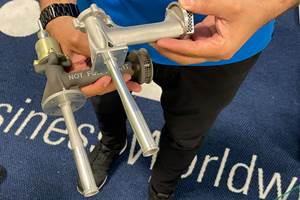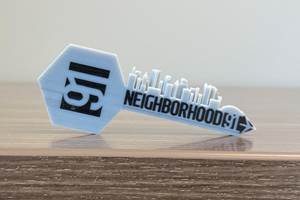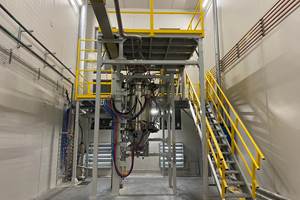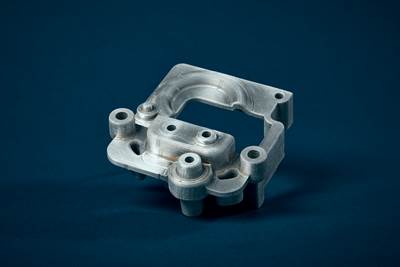Casting has traditionally been a good way to get high volumes of near-net-shape parts. But the process requires tooling and the use of a foundry, making supply chains for these parts longer and more complex. In an effort to simplify and consolidate supply chains, some manufacturers are looking to additive manufacturing as an alternative way to produce near-net-shape parts. In this episode of AM Radio, Peter Zelinski and I discuss recent examples we’ve seen of 3D printed parts replacing castings. Listen to the episode above, or read on for the show notes and transcript.
Transcript
Julia Hider
All right, welcome back. So at the end of the last segment, Pete, you were talking about how ceramic 3D printing is being used to aid the casting process. Now I want to discuss how additive manufacturing is being used to replace castings, which is something I feel like I've been hearing more about lately.
Peter Zelinski
Yeah, like I've seen some examples of that myself. Additive manufacturing enables casting, as we were talking about before the break, but in some cases it competes with and offers a replacement to casting as well. Yeah, let's let's talk about that. Where do you want to start?
Julia Hider
Let's just sort of talk about castings to start off. So castings have historically been used to get high volumes of near net shape parts that then usually need some sort of finishing operation. But castings extend a part’s supply chain and make it longer and more complex. So you need, you know, a mold or a die and then a foundry has to cast the part and ship them to the machine shop to finish them. And supply chain issues with this aren't new, but I feel like it's intensified with the labor shortages and all of the problems the industry has been experiencing. So manufacturers are exploring the idea of using additive manufacturing instead of casting to get to this near net shape part because it doesn't require tooling or a foundry.
Peter Zelinski
Casting requires a foundry. That's the thing. It's a type of process and facility that it's, it's just hard to start up. There's limited foundry capacity and foundry lead times have, have been extending and yeah, we're watching various manufacturers look at that. And yes, some companies are exploring alternatives through additive manufacturing in cases where that lead time is an issue.
Julia Hider
Yeah, one company that is working on this is Alloy Enterprises. They are a 3D printing startup that's targeting aluminum casting specifically, there's a lot of demand for parts made from aluminum because it's really strong and lightweight and recyclable. But these parts are traditionally made with casting and 3D printing aluminum with laser powder bed fusion is sort of challenging, so that's not always a good option either. So Alloy Enterprises developed an additive process that's specifically designed for high volume aluminum part production to compete with casting. And one of the keys to making this scalable is moving away from powder and using sheet lamination. They've developed a proprietary feedstock. But the production process for this material uses traditional aluminum production processes. It's a rolling process that's used to make aluminum foil and soda cans, so that it can be competitive in higher volume production. And the company also has this machine that cuts parts out of the aluminum sheets, they apply an inhibiting agent to create supports and overhangs. And they stack it all up and put it through a diffusion bonding process. So you end up with a block of 6061 aluminum and break away the supports to get all of the parts that are nested in there.
Peter Zelinski
Yeah, so Alloy Enterprises. They're a startup in the Boston area. I remember when you made the trip up to see them and they're, they're developing and working out their process sheet lamination, so that describes additive manufacturing in the form of stacking physical layers. And like I'm sure their process isn't this simple, but I'm hearing you talk and I'm getting the picture of just like stacking up and bonding layers of aluminum foil.
Julia Hider
Yeah, I think it's more complicated than that. But we can use that as a visual.
Peter Zelinski
What kind of parts did you see? Like what kind of components are really good to make out of their process?
Julia Hider
Yeah, so a lot of the parts are for industrial equipment manufacturers, but they also see a lot of potential for this in the automotive industry, especially as electric vehicles become more of a thing. It's a strong, lightweight material, so good for electric vehicles.
Peter Zelinski
And sheet lamination, where you're like, you've got each layer as a solid form. And you're just putting it down quickly, like you mentioned high volume at the start of this, and I could see how that would be a much faster metal 3D printing process.
Julia Hider
Yeah, and the whole idea is that they're going to compete at higher volumes. So that's definitely the intention.
Peter Zelinski
Okay, so additive manufacturing, providing a potential alternative to casting. What that makes me think of is a couple months ago, I visited Eaton’s new additive manufacturing production facility in South Carolina. Eaton does a lot, big company, but this, this plant, it has to do with aircraft components, and including like hydraulic components and fuel system components. And in a lot of cases, parts that used to be castings they are now converting them to additive manufacturing.
Julia Hider
Yeah. So what types of processes are they using?
Peter Zelinski
Powder bed fusion, so they laser powder bed fusion, electron beam powder bed fusion, they have right now, three different metal additive machines from three different providers, we’ll actually link the article in the show description, but more capability is coming, more machines on order. I mean, actually, it's possible there's more than three there now.
Julia Hider
So that's a really big change and investment to make, especially in an industry like aerospace, right?
Peter Zelinski
Like that's sort of key to this, every part that they make additively that they do this conversion, it's basically a new part that has to be requalified. And that requalification is a big effort that they're going through.
Julia Hider
Yeah, so why are they making this change?
Peter Zelinski
Well, there's, there's a couple reasons, foundry lead times, that we were talking about, that's part of this, if they can get away from reliance on foundries for at least some of their parts like it like it improves their flexibility and timing. But in addition, additive manufacturing lets them vertically integrate, instead of a foundry, they're now going to be making the initial near net shape part right on their own facility. And this, this additive facility was established on the campus of an existing production facility doing a lot of machining, a lot of machining on castings, but now they'll be doing machining on these metal additive parts. The difficulty of this, you alluded to it, it's the aircraft industry. So every part that they transition to 3D printing, it's basically a new part that has to be qualified all over again, the potential benefits of getting to additive manufacturing are so great that they're willing to go through the difficulty and expense of that requalification. And to the extent that Eaton is even partnering with its customers to share the burden of that requalification, because of all of the promise they see in this vertical integration and the improved service they can give to their customers. But also, as I've come to understand it, the requalification is kind of cumulative, the success with one part geometry partly applies to a future part with a similar geometry. So there is the very real expectation the qualification is going to get easier as they go. And this conversion to additive is like this, this this wheel that once they started turning can, they can get turning faster and faster.
Julia Hider
Yeah, so they're taking a very long-term view of this.
Peter Zelinski
Very much, they have been taking a long-term view, which is what's so interesting. So Eaton for quite a while had a variety of additive manufacturing, like call them tech centers, where they were just sort of demonstrating the capabilities of the process to customers and lots of companies are doing this, like we see facilities like that. So that work is now to an extent done for Eaton. They've made the case for additive. And so the next step now, they have built this production facility in South Carolina and it won't be the only one. So those tech centers now are increasingly being redirected toward additive production work.
Julia Hider
Yeah, so vertical integration is a good way to shorten a supply chain.
Peter Zelinski
Yeah, and it's, casting isn't going anywhere. Casting is going to be part of a lot of supply chains, but this will be interesting to watch the extent to which additive manufacturing does find its places as a casting replacement because there is real value and a lot of cases of consolidating, compressing that supply chain by bringing it all together, maybe even in one facility like the case with Eaton.
I feel like we're winding down here, but before we finish, speaking of transitions, we have to address, Julia, you're going to be making a change, aren't you?
Julia Hider
Yeah. So I'm going to be moving back to writing for Modern Machine Shop full time. So I'll still be around. If you ever want to talk about the intersection of machining and 3D printing, I'll still get to cover 3D printing in that capacity.
Peter Zelinski
We are going to miss you. This podcast is going to miss you because you've been a voice in this podcast from the very beginning. I am not at all going to say goodbye because…
Julia Hider
Our offices are still right next to each other.
Peter Zelinski
There’s that and also, in writing for Modern Machine Shop, you're gonna find all kinds of ways 3D printing is helping machine jobs and I insist that you come back to the podcast and talk about it. How about that?
Julia Hider
Sounds good.
Peter Zelinski
All right. I think we'll leave it at that. Julia, if you're going to leave the podcast for a while I think you should do our outro.
Julia Hider
Okay. All right. That does it for this episode of AM Radio, if you like the podcast make sure to subscribe on your podcast player of choice, share it with someone who might find it interesting and give us a five-star rating. Thanks for listening. That was my best take of doing the outro.
AM Radio is recorded with help from Austin Grogan and Seth Cooper. The show is edited by Alex Lytle and Stephanie Hendrixson. Artwork is by Kate Bilberry. AM Radio and Additive Manufacturing Media are products of Gardner Business Media located in Cincinnati, Ohio. I'm Julia Hider. Thanks for listening.
Related Content
Qualification Today, Better Aircraft Tomorrow — Eaton’s Additive Manufacturing Strategy
The case for additive has been made, Eaton says. Now, the company is taking on qualification costs so it can convert aircraft parts made through casting to AM. The investment today will speed qualification of the 3D printed parts of the future, allowing design engineers to fully explore additive’s freedoms.
Read MoreSeurat: Speed Is How AM Competes Against Machining, Casting, Forging
“We don’t ask for DFAM first,” says CEO. A new Boston-area additive manufacturing factory will deliver high-volume metal part production at unit costs beating conventional processes.
Read MoreWhat Is Neighborhood 91?
With its first building completely occupied, the N91 campus is on its way to becoming an end-to-end ecosystem for production additive manufacturing. Updates from the Pittsburgh initiative.
Read MoreCan the U.S. Become Self-Sufficient in Aerospace Alloy Metal Powders?
6K’s technology can upcycle titanium and nickel-alloy parts into additive manufacturing powder. Here is how the circular economy helps national security.
Read MoreRead Next
Aluminum Gets Its Own Additive Manufacturing Process
Alloy Enterprises’ selective diffusion bonding process is specifically designed for high throughput production of aluminum parts, enabling additive manufacturing to compete with casting.
Read MoreQualification Today, Better Aircraft Tomorrow — Eaton’s Additive Manufacturing Strategy
The case for additive has been made, Eaton says. Now, the company is taking on qualification costs so it can convert aircraft parts made through casting to AM. The investment today will speed qualification of the 3D printed parts of the future, allowing design engineers to fully explore additive’s freedoms.
Read MoreHybrid Additive Manufacturing Machine Tools Continue to Make Gains (Includes Video)
The hybrid machine tool is an idea that continues to advance. Two important developments of recent years expand the possibilities for this platform.
Read More




















